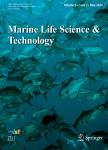Contrasting patterns of bacterial communities in the rearing water and gut of Penaeus vannamei in response to exogenous glucose addition
作者机构:State Key Laboratory for Managing Biotic and Chemical Threats to the Quality and Safety of Agro-ProductsNingbo UniversityNingbo315211China School of Marine SciencesNingbo UniversityNingbo315211China Zhejiang Institute of Freshwater FisheriesHuzhou313001China Zhejiang Mariculture Research InstituteWenzhou325005China
出 版 物:《Marine Life Science & Technology》 (海洋生命科学与技术(英文))
年 卷 期:2022年第4卷第2期
页 面:222-236页
核心收录:
基 金:funded by National Natural Science Foundation of China(31672658) Agricultural Major Project of Ningbo,China(2017C110001) Science and Technology Planning Project of Xiangshan County,China(2021XSX040003) K.C.Wong Magna Fund in Ningbo University
主 题:Glucose addition C/N ratio Shrimp Gut microbiota Bacterioplankton community
摘 要:Supplementing exogenous carbon sources is a practical approach to improving shrimp health by manipulating the microbial communities of aquaculture systems. However, little is known about the microbiological processes and mechanisms of these systems. Here, the effects of glucose addition on shrimp growth performance and bacterial communities of the rearing water and the shrimp gut were investigated to address this knowledge gap. The results showed that glucose addition significantly improved the growth and survival of shrimp. Although the α-diversity indices of both bacterioplankton communities and gut microbiota were significantly decreased by adding glucose, both bacterial communities exhibited divergent response patterns to glucose addition. Glucose addition induced a dispersive bacterioplankton community but a more stable gut bacterial community. Bacterial taxa belonging to Ruegeria were significantly enriched by glucose in the guts, especially the operational taxonomic unit 2575 (OTU2575), which showed the highest relative importance to the survival rate and individual weight of shrimp, with the values of 43.8 and 40.6%, respectively. In addition, glucose addition increased the complexity of interspecies interactions within gut bacterial communities and the network nodes from Rhodobacteraceae accounted for higher proportions and linked more with the nodes from other taxa in the glucose addition group than that in control. These findings suggest that glucose addition may provide a more stable gut microbiota for shrimp by increasing the abundance of certain bacterial taxa, such as Ruegeria.



